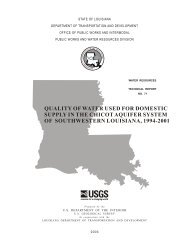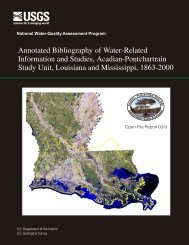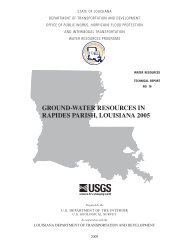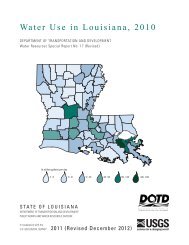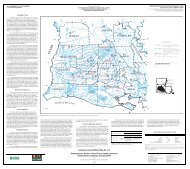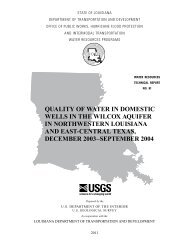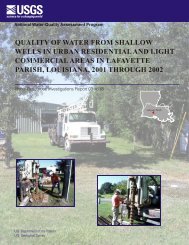environmental setting, water quality, and ecological indicators of
environmental setting, water quality, and ecological indicators of
environmental setting, water quality, and ecological indicators of
Create successful ePaper yourself
Turn your PDF publications into a flip-book with our unique Google optimized e-Paper software.
RELATIVE ABUNDANCE OF CAENIS SP. (MAYFLY)<br />
30<br />
20<br />
10<br />
0<br />
0 5 10 15 20 25<br />
0<br />
0 5 10 15 20 25<br />
30<br />
INSTREAM COVER SCORE<br />
40<br />
20<br />
10<br />
0<br />
0 10 20 30 40 50 60 70 80<br />
0<br />
0 10 20 30 40 50 60 70 80<br />
30<br />
PERCENTAGE OPEN CANOPY<br />
40<br />
20<br />
10<br />
0<br />
3 4 5 6 7 8 9 10<br />
30<br />
20<br />
10<br />
0<br />
0 1 2 3 4 5 6 7<br />
DISSOLVED OXYGEN, IN MILLIGRAMS PER LITER<br />
40<br />
MAXIMUM DISSOLVED FIPRONIL, IN MICROGRAMS PER LITER<br />
40<br />
30<br />
20<br />
10<br />
30<br />
20<br />
10<br />
0<br />
3 4 5 6 7 8 9 10<br />
30<br />
20<br />
10<br />
0<br />
0 1 2 3 4 5 6 7<br />
Figure 20. Relative abundances <strong>of</strong> Caenis sp. (mayfly) <strong>and</strong> Rheotanytarsus sp. (midge), <strong>and</strong> significant habitat <strong>and</strong><br />
<strong>water</strong>-<strong>quality</strong> variables identified by canonical correspondence analysis (CCA) for <strong>ecological</strong> data-collection sites in<br />
southwestern Louisiana, 2001. Increases in concentration <strong>of</strong> maximum dissolved fipronil was the only significant<br />
variable in the CCA model that was related to consistent decreases in relative abundance for many species.<br />
42<br />
30<br />
20<br />
10<br />
RELATIVE ABUNDANCE OF RHEOTANYTARSUS SP. (MIDGE)



